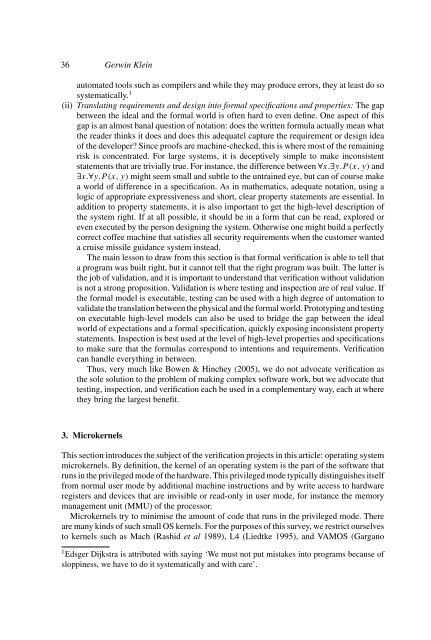Operating system verificationâAn overview
Operating system verificationâAn overview
Operating system verificationâAn overview
You also want an ePaper? Increase the reach of your titles
YUMPU automatically turns print PDFs into web optimized ePapers that Google loves.
36 Gerwin Klein<br />
automated tools such as compilers and while they may produce errors, they at least do so<br />
<strong>system</strong>atically. 1<br />
(ii) Translating requirements and design into formal specifications and properties: The gap<br />
between the ideal and the formal world is often hard to even define. One aspect of this<br />
gap is an almost banal question of notation: does the written formula actually mean what<br />
the reader thinks it does and does this adequatel capture the requirement or design idea<br />
of the developer? Since proofs are machine-checked, this is where most of the remaining<br />
risk is concentrated. For large <strong>system</strong>s, it is deceptively simple to make inconsistent<br />
statements that are trivially true. For instance, the difference between ∀x.∃y.P(x,y) and<br />
∃x.∀y.P(x,y) might seem small and subtle to the untrained eye, but can of course make<br />
a world of difference in a specification. As in mathematics, adequate notation, using a<br />
logic of appropriate expressiveness and short, clear property statements are essential. In<br />
addition to property statements, it is also important to get the high-level description of<br />
the <strong>system</strong> right. If at all possible, it should be in a form that can be read, explored or<br />
even executed by the person designing the <strong>system</strong>. Otherwise one might build a perfectly<br />
correct coffee machine that satisfies all security requirements when the customer wanted<br />
a cruise missile guidance <strong>system</strong> instead.<br />
The main lesson to draw from this section is that formal verification is able to tell that<br />
a program was built right, but it cannot tell that the right program was built. The latter is<br />
the job of validation, and it is important to understand that verification without validation<br />
is not a strong proposition. Validation is where testing and inspection are of real value. If<br />
the formal model is executable, testing can be used with a high degree of automation to<br />
validate the translation between the physical and the formal world. Prototyping and testing<br />
on executable high-level models can also be used to bridge the gap between the ideal<br />
world of expectations and a formal specification, quickly exposing inconsistent property<br />
statements. Inspection is best used at the level of high-level properties and specifications<br />
to make sure that the formulas correspond to intentions and requirements. Verification<br />
can handle everything in between.<br />
Thus, very much like Bowen & Hinchey (2005), we do not advocate verification as<br />
the sole solution to the problem of making complex software work, but we advocate that<br />
testing, inspection, and verification each be used in a complementary way, each at where<br />
they bring the largest benefit.<br />
3. Microkernels<br />
This section introduces the subject of the verification projects in this article: operating <strong>system</strong><br />
microkernels. By definition, the kernel of an operating <strong>system</strong> is the part of the software that<br />
runs in the privileged mode of the hardware. This privileged mode typically distinguishes itself<br />
from normal user mode by additional machine instructions and by write access to hardware<br />
registers and devices that are invisible or read-only in user mode, for instance the memory<br />
management unit (MMU) of the processor.<br />
Microkernels try to minimise the amount of code that runs in the privileged mode. There<br />
are many kinds of such small OS kernels. For the purposes of this survey, we restrict ourselves<br />
to kernels such as Mach (Rashid et al 1989), L4 (Liedtke 1995), and VAMOS (Gargano<br />
1 Edsger Dijkstra is attributed with saying ‘We must not put mistakes into programs because of<br />
sloppiness, we have to do it <strong>system</strong>atically and with care’.
















